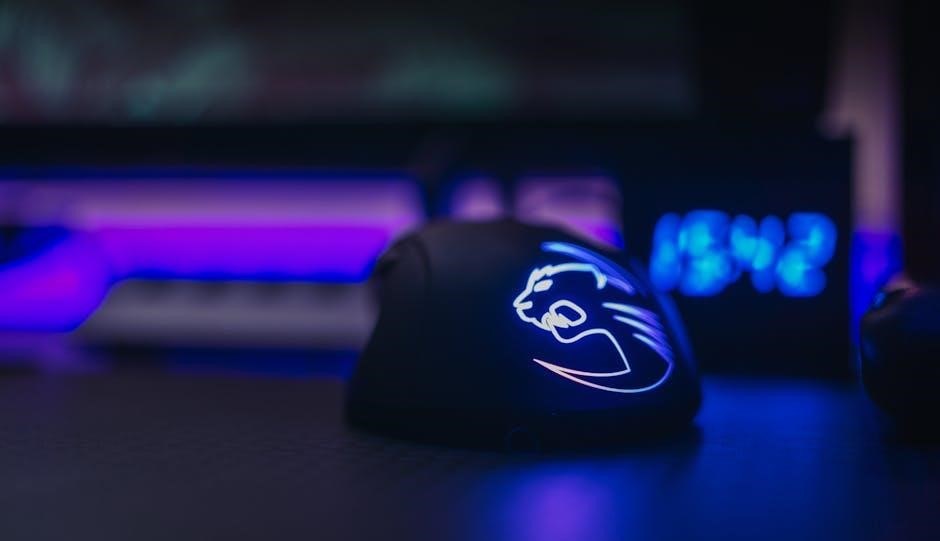Peripheral neuropathy, a condition causing nerve damage, often leads to pain, numbness, and weakness. Exercise plays a crucial role in managing symptoms, improving circulation, and enhancing overall well-being.
Understanding Peripheral Neuropathy and Its Symptoms
Peripheral neuropathy is a condition characterized by damage to the peripheral nerves, often causing symptoms like tingling, numbness, and burning pain in the hands and feet. It can result from diabetes, injuries, infections, or nutritional deficiencies. Some individuals may experience muscle weakness or difficulty with balance and coordination. In severe cases, it can lead to complete loss of sensation or motor function. Early recognition of symptoms is crucial for effective management. While the condition can be challenging, exercises and lifestyle modifications play a significant role in alleviating discomfort and improving quality of life. Understanding the underlying causes and symptoms helps in developing targeted strategies to manage the condition effectively;
The Role of Exercise in Managing Peripheral Neuropathy
Exercise is a cornerstone in managing peripheral neuropathy, offering numerous benefits that extend beyond symptom relief. Regular physical activity improves blood circulation, which helps nourish damaged nerves and promote healing. It also enhances balance and coordination, reducing the risk of falls. Strengthening muscles through exercise can compensate for weakness caused by neuropathy, improving mobility and independence. Additionally, exercise contributes to overall health by managing conditions like diabetes, a common cause of neuropathy. A well-structured exercise routine can significantly improve quality of life, making it an essential component of a comprehensive treatment plan. By incorporating aerobic, balance, and stretching exercises, individuals can better manage their condition and maintain functional abilities.

Types of Exercises Recommended for Peripheral Neuropathy
Recommended exercises include aerobic, balance, stretching, resistance, and low-impact activities. These promote circulation, strength, flexibility, and stability, aiding in managing neuropathy symptoms effectively and safely.
Aerobic Exercises for Improving Circulation
Aerobic exercises, such as walking, swimming, and cycling, are highly recommended for peripheral neuropathy. These activities improve blood flow and oxygen delivery to damaged nerves, reducing symptoms like numbness and tingling. Regular aerobic exercise enhances circulation, promoting nerve health and aiding in the repair of nerve damage. It also boosts overall cardiovascular health, which is essential for managing conditions often associated with neuropathy, such as diabetes. Low-impact aerobics are ideal, as they minimize stress on joints while maximizing benefits. Consistency is key, with at least 30 minutes of moderate-intensity aerobic activity most days of the week. Always consult a healthcare provider before starting a new exercise program to ensure safety and effectiveness.
Balance Exercises to Prevent Falls
Balance exercises are essential for individuals with peripheral neuropathy, as nerve damage can impair coordination and increase fall risk. Simple activities like single-leg stands, heel-to-toe walking, and tai chi improve stability and reduce the likelihood of falls. These exercises strengthen core muscles and enhance proprioception, the body’s ability to sense position and movement. Using props, such as a chair or wall for support, can help build confidence and safety. Regular practice of balance exercises not only improves physical stability but also reduces fear of falling, promoting independence and overall quality of life. Consistency is key, with short, daily sessions yielding significant benefits over time. Always consult a healthcare provider to tailor exercises to individual needs and abilities.
Stretching Exercises to Enhance Flexibility
Stretching exercises are vital for improving flexibility and reducing stiffness in individuals with peripheral neuropathy. Hamstring stretches, seated stretches, and calf stretches are particularly beneficial. These exercises help maintain joint mobility and relieve muscle tightness, which can worsen neuropathy symptoms. Start with gentle movements and gradually increase intensity. Holding stretches for 20-30 seconds and repeating them 2-3 times ensures maximum benefit. Always avoid bouncing, as it can cause injury. Stretching also improves circulation, which is crucial for nerve health. Incorporating stretching into a daily routine can significantly enhance comfort and mobility, allowing individuals to perform daily activities with greater ease. Regular stretching promotes long-term flexibility and supports overall physical well-being. Always consult a healthcare provider before beginning any new exercise program.
Resistance Training for Muscle Strength
Resistance training is a key component of managing peripheral neuropathy, as it helps build muscle strength and improves overall physical function. Exercises such as leg extensions, arm curls, and resistance band workouts are effective. These activities enhance muscle mass, which supports better blood sugar regulation and metabolism. Resistance training also improves balance and reduces the risk of falls. Start with light weights or resistance bands and gradually increase intensity. It’s important to focus on controlled movements to avoid injury. Supervision by a physical therapist or healthcare provider is recommended, especially for those with severe neuropathy. Consistent resistance training can lead to noticeable improvements in muscle strength and overall mobility, making daily activities easier and safer to perform. Regular practice fosters long-term benefits for both physical health and independence.
Low-Impact Exercises for Joint Health
Low-impact exercises are essential for maintaining joint health while managing peripheral neuropathy. Activities like swimming, cycling, and yoga are ideal as they minimize joint strain. These exercises improve circulation, which is crucial for nerve health, and strengthen muscles without overexertion. Swimming, for instance, provides a full-body workout while being gentle on the joints. Cycling, whether on a stationary bike or outdoors, enhances cardiovascular fitness and muscle endurance. Yoga improves flexibility and balance, reducing the risk of falls. Consistency is key, as regular low-impact exercise helps maintain mobility and prevents joint deterioration. Always start slowly and gradually increase intensity to avoid injury. These exercises not only support joint health but also contribute to overall well-being, making them a vital part of a comprehensive management plan for peripheral neuropathy.

Creating a Safe and Effective Exercise Routine
Creating a safe exercise routine for peripheral neuropathy involves consulting a healthcare provider, starting slowly, wearing proper footwear, and monitoring progress to ensure safety and effectiveness.

How to Start an Exercise Program for Peripheral Neuropathy
Starting an exercise program for peripheral neuropathy requires careful planning and consultation with a healthcare provider. Begin with low-intensity activities like seated marching or gentle ankle rolls. Wear proper footwear and orthotics to protect sensitive feet. Gradually increase duration and intensity, focusing on balance, flexibility, and strength. Prioritize exercises that improve circulation, such as short walks or swimming, to reduce numbness and tingling. Monitor progress and adjust routines to avoid overexertion or discomfort. Keeping a journal can help track improvements and identify any challenges. Consistency is key to achieving long-term benefits and enhancing overall mobility and well-being.
Modifying Exercises to Suit Individual Needs
Exercises for peripheral neuropathy should be tailored to each person’s specific condition and abilities. Consulting a physical therapist is essential to create a personalized plan. For those with balance issues, seated or wall-supported exercises are recommended. If mobility is limited, chair yoga or gentle stretching can be effective. Resistance bands are useful for strengthening without heavy equipment. Individuals with foot sensitivity should opt for low-impact activities like swimming or cycling. Progressive resistance exercises can gradually build muscle strength. Regularly reassessing and adjusting the routine ensures continued progress and avoids plateaus. Customization helps maximize benefits while minimizing risks, making exercise a sustainable part of managing peripheral neuropathy.

Preventing Complications Through Exercise
Exercise helps prevent complications like foot ulcers and infections by improving circulation and balance. Regular activity strengthens muscles, supports joints, and reduces fall risks, enhancing overall stability and health.
Foot Care and Proper Footwear During Exercise
Proper foot care and footwear are essential for individuals with peripheral neuropathy to prevent complications during exercise. Wearing supportive, non-restrictive shoes with cushioning can reduce pressure on sensitive areas. Inspecting feet daily for blisters, cuts, or signs of irritation is crucial, as nerve damage can mask pain. Moisturizing feet helps prevent cracks that may lead to infections. During exercise, avoid tight footwear that restricts circulation. Opt for breathable materials and orthotics if recommended by a healthcare professional. Neglecting foot care can lead to serious issues like ulcers or infections, which may worsen neuropathy symptoms. Prioritizing foot health ensures safer and more effective physical activity, improving overall well-being and reducing the risk of exercise-related injuries.
Avoiding Overexertion and Injury
Avoiding overexertion is vital for individuals with peripheral neuropathy to prevent injuries and setbacks. Overexertion can exacerbate nerve damage, leading to increased pain or discomfort. It’s important to listen to the body and set realistic limits during exercise. Starting with low-intensity activities and gradually increasing intensity helps build strength without causing harm. Proper warm-up and cool-down routines are essential to prepare muscles and prevent strain. Additionally, using assistive devices, such as canes or braces, can provide stability and reduce the risk of falls. Consulting with a healthcare provider or physical therapist to tailor exercises appropriately ensures a safe and effective routine, minimizing the risk of injury and promoting long-term recovery and management of neuropathy symptoms.

The Role of Exercise in Long-Term Management
Regular exercise is essential for long-term management of peripheral neuropathy. It improves circulation, enhances muscle strength, and boosts overall well-being, helping to manage symptoms and prevent complications effectively.

Exercise as Part of a Comprehensive Treatment Plan
Exercise is a cornerstone of managing peripheral neuropathy when integrated into a comprehensive treatment plan. It complements medical therapies, improving circulation, strength, and balance while reducing pain. Aerobic, stretching, and resistance exercises enhance nerve function and overall well-being. A tailored program, combined with proper footwear and regular monitoring, ensures long-term symptom relief. Consulting healthcare professionals is crucial to create a personalized routine, addressing individual needs and preventing complications. Consistency in exercise, alongside lifestyle adjustments, fosters better symptom control and improved quality of life for those with peripheral neuropathy.